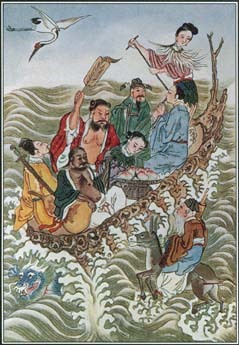Xian
In the Taoist mythology of China, the Xian (or Hsien) are a group of eight immortal characters who at one time lived as humans on earth. Some of the Xian were real individuals mentioned in historical records; others appear only in myths and legends.
Popular subjects in Chinese mythology and art, the Xian are said to travel the universe together in a state of perfect health and happiness. They perform various wonders and miracles and serve as models for those seeking the tao, or way—the path to an ideal state of being and existence. In Chinese art, these Eight Immortals often appear as a group, each depicted with his or her own characteristic clothing and possessions.
immortal able to live forever
How the Xian Achieved Immortality. The stories about the Xian explain how each achieved immortality in a different way. The first to reach this state was Li Tieguai (Iron Crutch), a hermit who went 40 years without food or sleep. According to some stories, Li Tieguai acquired immortality and his crutch from the Queen Mother of the West, who saw him limping and begging. Other legends say that Laozi, the founder of Taoism, came down from heaven to teach Li Tieguai the wisdom of the gods. One day Li sent his spirit to Laozi. When he returned, he found that a follower had burned his body, believing him to be dead. So Li entered the body of a deformed beggar who had died, gaining both immortality and a new identity.
Several different tales tell of the life of Han Zhongli, an army officer and state official. Some stories say that after losing a battle he went into the mountains, became a hermit, and learned the secret of immortality from the Flowers of the East. Other tales say that he was a priest or a beggar and that he discovered a jade box containing the magic potion of eternal life. In art, Han Zhongli is usually portrayed as a bearded old man holding a fan made of feathers.
Lu Dongbin. The most famous of the Xian was Lu Dongbin, a prince who traveled throughout China slaying dragons with a magic sword. One day he met Han Zhongli at an inn, and later that night he dreamed that his royal life would end in disgrace. When he awoke, he turned his back on worldly things and followed Han Zhongli into the mountains to seek the tao and gain immortality. Lu Dongbin is usually shown carrying a sword.
The grandnephew of a great statesman and poet, Han Xiang became a follower of Lu Dongbin. While climbing a sacred peach tree one day, he fell from the branches and achieved immortality before he reached the ground. Some stories say he died as a result of the fall and was then transformed into an immortal. Han Xiang is shown in art carrying a basket of flowers.
Cao Guojiu was the brother of an empress. Disgusted by the corruption at the royal court, he went into the mountains to seek the tao. He met a boatman on the way and showed him a golden tablet that would admit the holder to the royal court. The boatman—Lu Dongbin in disguise—was not impressed, but he took Cao Guojiu as a disciple and taught him the tao and the secret of immortality. In art, Cao Guojiu appears wearing official robes and carrying his golden tablet.
The immortal Zhang Guolao was also a hermit. Famous for his skills in magic, he traveled around on a white mule that he could fold up like a sheet of paper and put into a carrying bag. Many stories say that

The immortal Lan Caihe sometimes appears as a man and other times as a woman. One day while gathering medicinal herbs, Lan Caihe met a beggar and helped tend the sores on his body. The beggar was Li Tieguai in disguise, and he rewarded this kindness by granting Lan Caihe immortality. Lan Caihe traveled around the country in a tattered blue dress, urging people to seek the tao. He is usually shown with a flute or a basket of fruit.
The eighth Xian, He Xiangu, is the only one who is definitely a woman. As a young girl, He Xiangu dreamed that a spirit told her to grind up and eat some mother-of-pearl. She did this and became immortal. Thereafter, she floated from mountain to mountain gathering herbs and fruit. Artists generally portrayed her as a beautiful woman wearing a lotus flower in her hair or on her clothing.
The Qi Xian. The Eight Immortals were also known as the Ba Xian, a title that distinguished them from the Qi Xian, a group of seven Chinese poets and scholars who lived in the A.D. 200s. The Qi Xian, known as the Seven Sages of the Bamboo Grove, were historical figures who retreated to the countryside to write works that embraced Taoist ideas and that criticized the corruption of the royal court. Their self-imposed exile served as a model for later Chinese writers seeking to escape worldly troubles.
See also Chinese Mythology .
Comment about this article, ask questions, or add new information about this topic: